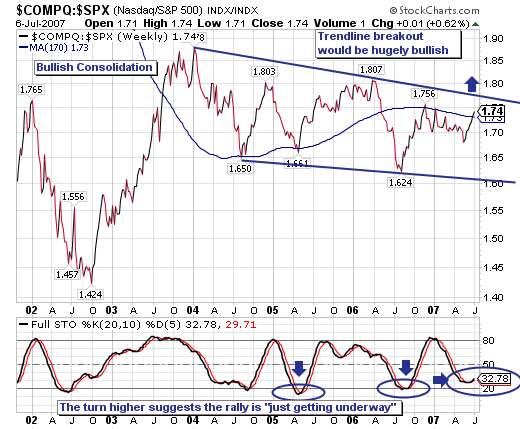The Dow is poised to re-test the 13,700 level next week. If it is able to break above that level, it will be a very bullish development indeed. Given that the Dow has faltered just below that level twice in the previous two months, odds are it will fail again this time. Smart ChartWatchers will be watching closely however - our Dow Gallery View charts are a great place to watch the action.
TAKING A LOOK AROUND
For the past 18 months or so, I'm been putting periodic updates in this newsletter about the progress of our new datacenter project. Now that things are complete, I thought I'd show you a couple of pictures of the new facility. The key problems that we were facing in our old datacenter were a lack of cooling and a lack of power. All of the new computers we had added were taking too much power and generating too much heat for our old systems.
To fix the cooling problem, we installed a very large "chiller" unit outside of our offices that chills water and pumps it through a closed loop of pipes into four "In Row Cooling (IRC)" units located next to our server racks. The IRCs are essentially big radiators with fans that suck in the hot air that our servers generate and force it through coils that are full of the chilled water from the outside chiller. They then blow the chilled air out the front so it can re-enter the front of our servers.
Here's a picture of the outside chiller:
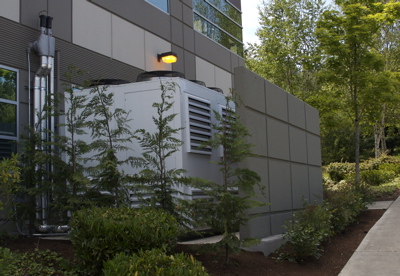
And here's a shot of the inside of our datacenter:
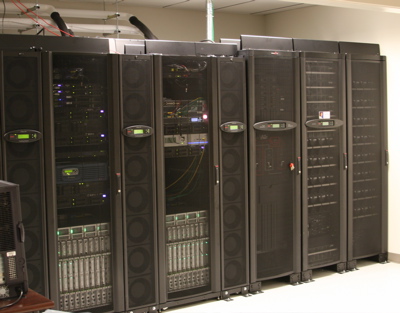
The thinner cabinets located in-between each of the larger server racks are the IRCs I was talking about. Notice the large white pipes up above the racks? They deliver cold water from the outside chiller and remove the heated water from the IRCs.
Over on the far right side of the picture are three full racks that contain our new "Uninterruptable Power Supply (UPS)." The new UPS can power all of our servers for over 2 hours in the event of our power failure. That's over twice as long as our old UPS even though it is powering almost twice as many servers!
Speaking of servers, the big silver things at the bottom of the other two racks are our two new Sun Blade 8000 chassis. Each Sun chassis contains ten blade servers and each server contains four 2.8GHz AMD Opteron processors. If you do the math, that means that each chassis provides 112 GHz of computing power and, as of last week, we now have two fully populated chassis for 224 GHz of chart crunching power. These new blades are able to generate charts almost twice as fast as our previous blades but they use lots of power and generate lots of heat. We could never have installed them without the power and cooling improvements to our new datacenter.
(BTW, The Thomson datafeed servers that have been causing us so much trouble recently are located at the top of the rack on the left side of that picture.)
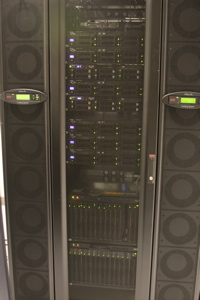 Finally, here's a shot of our "data" rack. The upper half contains the larger Dell 2950 servers that store all of our historical stock data. Lower down are the two IBM BladeCenter chassis that contain the smaller blade servers that used to generate our charts - they are now being converted to run other areas of our site.
Finally, here's a shot of our "data" rack. The upper half contains the larger Dell 2950 servers that store all of our historical stock data. Lower down are the two IBM BladeCenter chassis that contain the smaller blade servers that used to generate our charts - they are now being converted to run other areas of our site.
There are lots of other parts of our Datacenter that I'd love to show you but I should probably save those for some other day. Hopefully this quick glimpse helps you see how we've been working hard to continually upgrade the equipment that runs our website. These upgrades should allow us to continue providing our charts for years to come.
When performing market analysis it is best to first look at the long-term view of what is happening because it provides us with the relevant context for analysis of shorter-term market action. With this in mind, on the weekly bar chart we can see that the S&P 500 Index is still trending higher inside a rising trend channel. However, at the present time it is moving down after having reached the top of the channel. While this could very well be the last top before a major decline, we are in a bull market and we have to assume any decline will be stopped by the rising trend line.
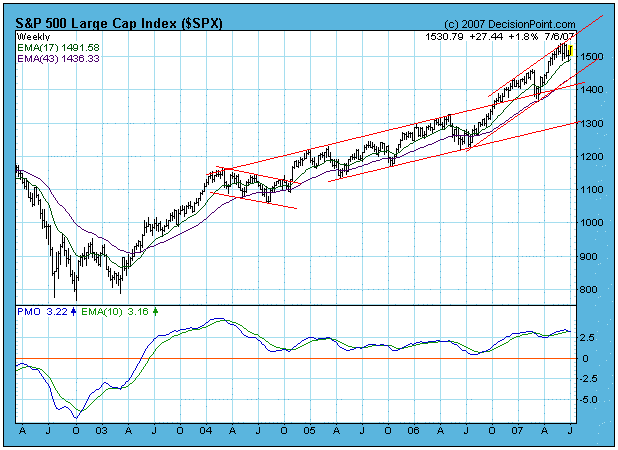
On the second chart we move in for a closer look, and we can see that prices have been consolidating for more than a month. Will this consolidation resolve as a double or triple top, or is it building a base for another leg upward? After looking at my cycle projections, I can imagine one scenario that we might see.
The March low was a 9-Month Cycle trough. The next subordinate cycle within the 9-Month Cycle is the 20-Week Cycle â there are two of them in a 9-Month Cycle. It appears that the market is now in the process of cresting in preparation for a decline into the next 20-Week Cycle trough, which is projected to arrive at the end of this month.
It is important to understand that you cannot set your watch by cycle projections, and we cannot know precisely what kind of price pattern will emerge, but cycle projections provide an intuitive framework for interpreting market action. For now I think we should be looking for a down thrust that may ultimately prove to be the current 20-Week Cycle trough. It could have happened already, or it may not happen for several weeks, but we are in the "window".

What I think may happen is that a decline in the next few weeks will break down through the support at the bottom of the consolidation range, leading very quickly to the cycle trough. Such a breakdown would likely prove to be a bear trap because of the likelihood of an upside reversal out of that trough as the next 20-Week Cycle begins.
Bottom Line: Please understand that this is just an educated guess, but a guess nonetheless. There are many other ways this could play out, but my main point is to emphasize that the next 20-Week Cycle trough is more likely to be a buying opportunity than the beginning of a serious decline. I'm not suggesting that you try to pick the bottom, just be alert for the possibility and use your standard entry techniques.
The U.S. Dollar Index is approaching levels not seen since 1992. The reasons are fairly obvious. Global interest rates are on the rise and our own interest rates have been on hold for 8 straight meetings. As foreign interest rates rise, foreign currencies generally strengthen, weakening the US dollar on a relative basis. The Fed could act to raise our rates and strengthen the dollar, but we don't see that occurring - at least not at this time.
Refer to Chart 1 below to see how the recent changes in Fed policy have affected the U.S. Dollar Index. The green arrow reflects the beginning of 13 interest rate increases that spanned two and one half years. The red arrow reflects the beginning of 17 interest rate decreases that spanned two years. The black arrow marks the beginning of a period of status quo, where interest rates have not budged.

In 2002, the U.S. Dollar Index began tumbling, and notice what happened to the Gold and Silver Index as shown in Chart 2. A weaker dollar will result in higher gold and silver prices. If the dollar continues depreciating, be sure to consider upping your exposure to the XAU.

If opportunity knocks, be prepared.
In November-2006, we noted that if one previewed the NASDAQ Composite/S&P 500 Ratio, one would find a very well pronounced and bullish consolidation forming. Well, its been 3 ½ years and the consolidation is still forming; however, there are emerging technical signs that a major breakout is forthcoming â one that would see technology stocks move to the forefront of market leadership in a manner not seen since the October-2002 to January-2004 relative rally that took the ratio from 1.42 to 1.88. Moreover, the rally could well become explosive to the upside.
First, we would call attention to the nascent breakout above the 170-week moving average; in the past this has provided a fulcrum point for trend reversals. And perhaps this is the case at present given the breakout above this level is not yet sufficient to warrant an "all clear" siren; but â the 20-week stochastic is just now turning higher from oversold levels consistent with past rallies of at least 0.14. If this circumstance were to occur this time, then we would see the ratio breakout above the bullish consolidation's trendline resistance level and above the April-2006 level of 1.81... putting the ratio at its highest level since late-2003 or early-2004.
Finally, on further confirmation of this nascent breakout, our upside target guide using the October-2002 rally into January-2004 rally would be around 2.07, with the time within 12-18 months. .Thus, it would seem wise to trade this "pairs trade" using a long QQQQ/short SPY position. Or, if one believes the markets is headed higher from current levels or if one must be long for any stylistic reason â then perhaps selected outright long positions in technology are warranted. In any case... the unloved technology sector is poised to gain substantial sponsorship.
